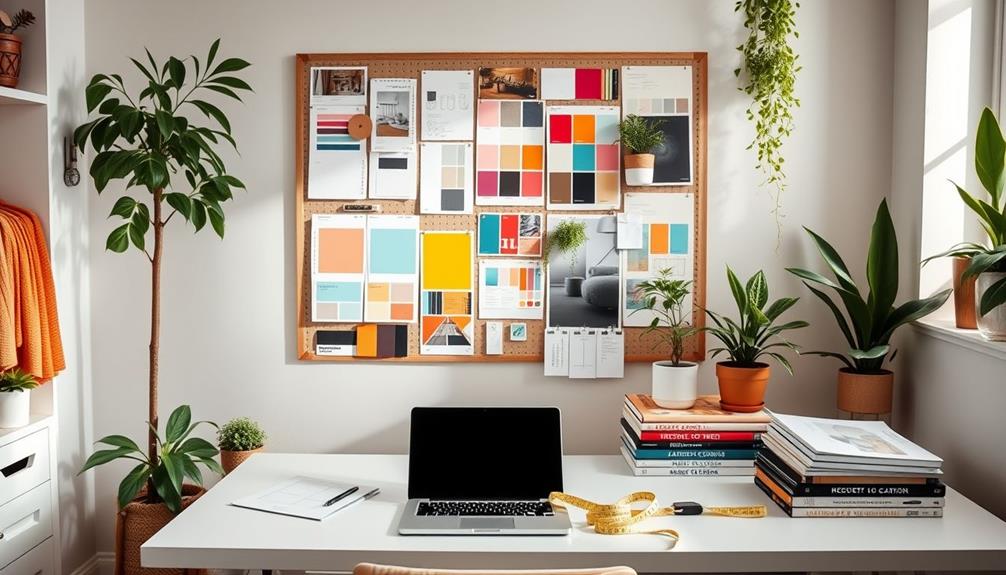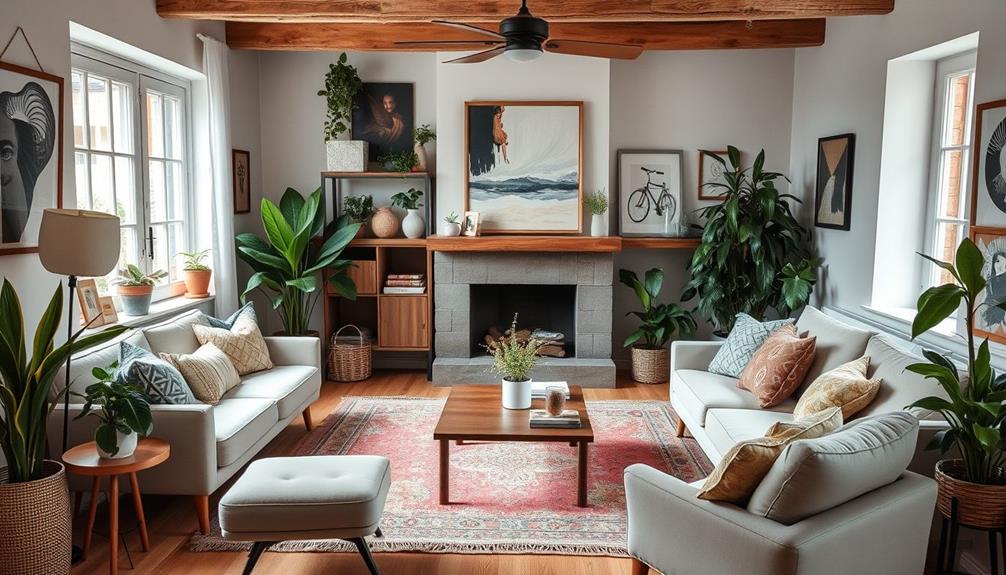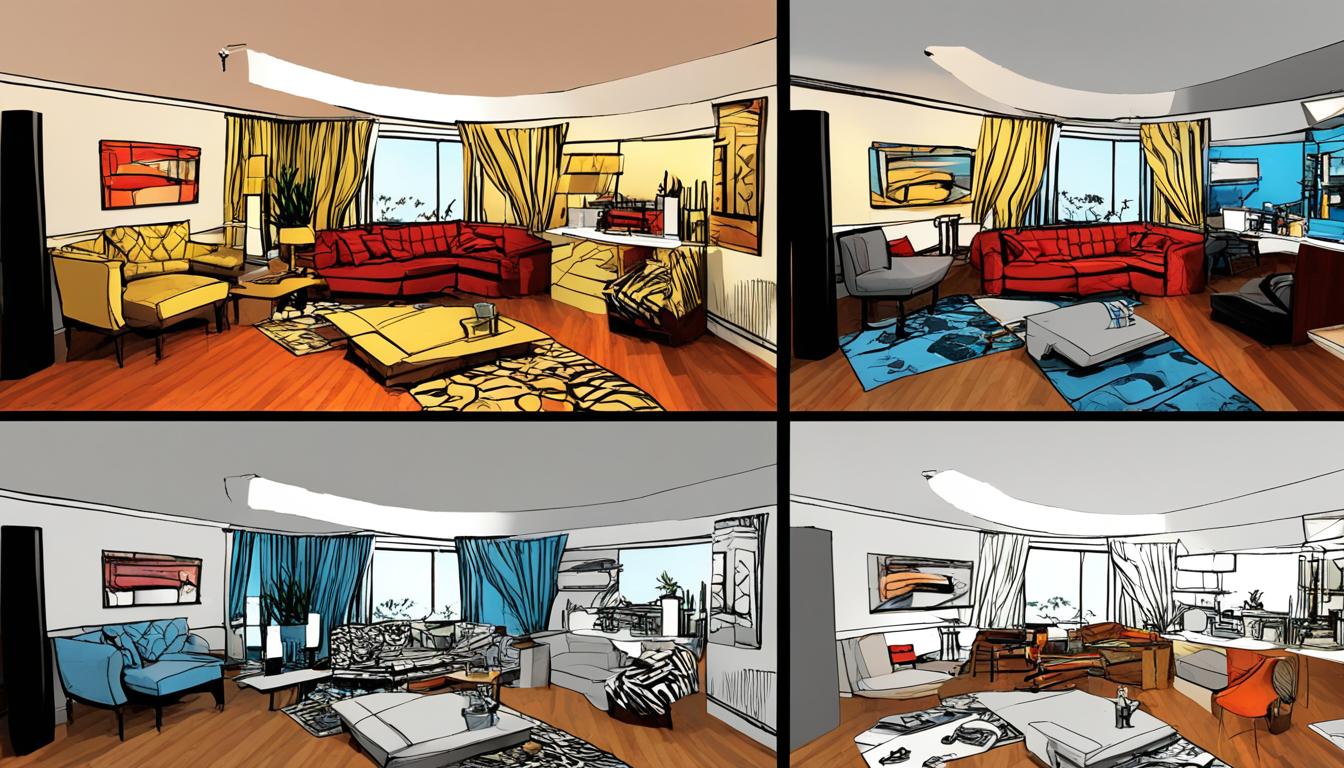To start an interior design business, you should first define your service offerings, ensuring differentiation in areas like kitchen design and full-service renovations. Next, identify your unique design style, aligning it with client needs through mood boards. Choosing a memorable business name is essential as it reflects your vision and appeals to your target market. Developing an engaging website with a robust portfolio not only showcases your work but also enhances online visibility through effective SEO strategies. Finally, implementing sound financial and marketing plans will secure client relationships and sustain growth. Exploring these elements further will illuminate the path ahead.
Key Takeaways
- Define your service offerings clearly to establish a brand identity and meet market demands effectively.
- Identify and reflect your unique design style to attract your ideal clients in a competitive market.
- Choose a catchy and professional business name that resonates with your target audience and check its availability.
- Develop a user-friendly, SEO-optimized website to showcase your portfolio and establish your online presence.
- Create a comprehensive business plan with financial projections and a budget for startup costs to ensure sustainability.
Define Your Service Offerings

When you're starting an interior design business, it's essential to define your service offerings clearly. By identifying the specific services you'll offer—such as kitchen design, bathroom renovations, e-design, or full-service interior design—you cater to the unique needs of your potential clients.
A thorough list of deliverables for each service not only enhances transparency but also sets clear expectations. For instance, if you provide e-design services, you might include virtual consultations and detailed design plans, whereas full-service offerings involve hands-on project management and installation.
It's also important to differentiate between these types of services to streamline your business model and avoid potential confusion. By setting clear limitations on your offerings, you guarantee that you don't overcommit, allowing you to maintain the quality that clients expect.
Regularly evaluating and aligning your services with market demands can keep you competitive in the ever-evolving interior design industry. This process of reflection allows you to adapt, guaranteeing your offerings resonate with your target clientele.
Ultimately, defining your service offerings not only establishes your brand identity but also lays the groundwork for a successful, client-focused interior design business.
Identify Your Design Style

To attract your ideal clients, identifying your design style is essential. In a competitive market where 80% of consumers seek personalized design solutions, your unique aesthetic can set you apart.
Begin by researching popular design styles—like mid-century modern, contemporary, or rustic—to discern which resonates with your personal preferences and aligns with current market trends. For instance, exploring the elements of Mid-Century Modern Design can provide inspiration on how to blend nostalgia with contemporary style.
Consider your design experience; your style should reflect your individuality while still addressing client needs. Creating a mood board can be particularly beneficial, as it visually encapsulates your design style through color palettes, furniture selections, and textures, ultimately serving as a reference for your brand identity.
Engaging with local design communities or online forums allows you to gather insights about emerging trends and client preferences, which can help refine and evolve your design approach.
- Analyze your past projects to identify patterns in your design choices.
- Use social media platforms to observe and gather inspiration from contemporary designers.
- Attend design workshops to broaden your understanding of various styles.
- Stay updated on design publications to keep abreast of market trends.
Choose a Business Name

After honing in on your unique design style, the next step is to choose a business name that reflects your identity and offerings. This name should resonate with your target audience while encapsulating the essence of your creative vision.
Start by brainstorming names that echo your design style and the specific services you provide, ensuring they align with your market niche. Once you've generated a shortlist, check the availability of your chosen name through your state's Secretary of State website to avoid potential conflicts with existing businesses.
Including your personal name in the title can add a personal touch, enhancing brand recognition and fostering a sense of connection with clients. Aim for a catchy, easy-to-pronounce name that conveys both professionalism and creativity, as this will make it memorable to potential clients.
Develop Your Website
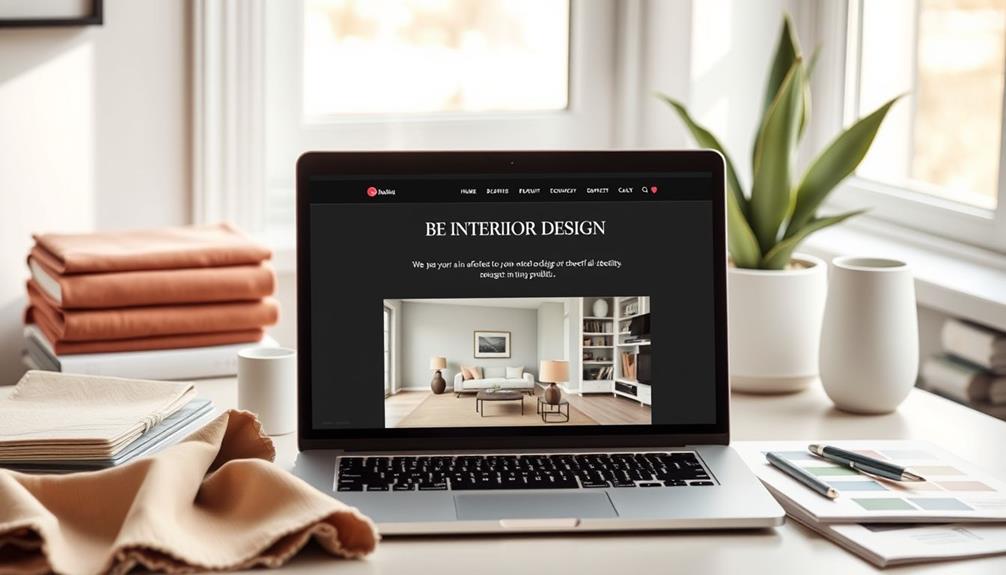
In developing your website, you'll want to carefully consider your domain name, ensuring it not only reflects your interior design business but is also memorable and easy to spell, as this will greatly influence your brand's visibility.
Additionally, employing user-friendly platforms like WordPress or Squarespace allows you to create a visually engaging layout that highlights your portfolio, while integrating SEO strategies helps optimize your content for search engines, thereby increasing your chances of attracting potential clients.
As you navigate these essential elements, think about how WordPress serves as a popular CMS and a dedicated blog section can further enhance your site by establishing your expertise and fostering client engagement through valuable insights into design trends and tips.
Domain Name Selection
Choosing the right domain name is essential for establishing your interior design business online. This seemingly simple step carries significant implications for your branding and SEO efforts. A well-chosen domain name should be short, memorable, and reflective of your brand identity, ideally incorporating keywords related to interior design to enhance your visibility on search engines.
Consider these key factors when selecting your domain name:
- Ascertain it's unique by checking its availability on registration platforms like GoDaddy or Namecheap.
- Opt for a .com extension, as it's the most recognized and lends credibility to your business.
- If your desired name is taken, consider using your name or a creative variation to enhance personal branding.
- Register your domain promptly, as available names can be quickly claimed by others, risking your online presence.
As you navigate this process, remember that your domain name is more than just a web address; it's a foundational element of your business identity. It influences how clients perceive you and your services in the competitive interior design market.
With the right domain, you can effectively communicate your expertise and attract your target audience.
Website Design Essentials
Developing a professional website is crucial for showcasing your interior design business and attracting potential clients. A well-crafted site not only reflects your unique identity through a carefully chosen domain name but also serves as a platform to exhibit your portfolio and connect with prospective clients. To create an engaging website, take into account using user-friendly platforms like WordPress or Squarespace, which facilitate visually appealing designs that enhance user experience.
Here's a concise overview of key elements to keep in mind:
| Essential Element | Importance | Best Practices |
|---|---|---|
| Domain Name | Reflects your business identity | Choose a name that's memorable |
| High-Quality Images | Captures attention and showcases work | Use professional photography |
| Mobile-Responsive | Guarantees accessibility for all users | Optimize for various screen sizes |
Moreover, integrating SEO best practices—such as relevant keywords and alt text for images—can greatly improve your site's visibility in search results. Finally, including testimonials will enhance your credibility, fostering trust with visitors. By prioritizing these website design essentials, you lay a solid foundation for your interior design business's online presence.
SEO Optimization Strategies
Maximizing your website's visibility is essential for attracting clients in the competitive interior design industry. An effective search engine optimization (SEO) strategy not only enhances your online presence but also considerably contributes to the success of your new interior design business.
To optimize your website effectively, consider the following strategies:
- Utilize keyword research tools, like Google Keyword Planner, to discover relevant phrases potential clients might use when searching for design services. Implementing keyword clustering can further enhance your SEO by organizing related terms to improve content discoverability.
- Optimize your website's metadata, including title tags and meta descriptions, making them concise and descriptive while incorporating targeted keywords to improve click-through rates.
- Create high-quality, original content that addresses common client inquiries or current trends in interior design, establishing your site's authority through content marketing.
- Ascertain your website is mobile-friendly, acknowledging that over half of global web traffic originates from mobile devices, which Google prioritizes in its rankings.
Create Your Portfolio

Your portfolio is the cornerstone of your interior design business, serving as a visual demonstration of your creativity and expertise. To create beautiful and impactful portfolios, begin by including high-quality images of your personal design projects, effectively showcasing your ability to transform spaces.
It's vital to incorporate a variety of design styles and palettes; doing so not only attracts a diverse clientele but also reflects your versatility and adaptability in the field.
Consider utilizing before-and-after photos, as they vividly illustrate the transformative nature of your work and underscore your problem-solving skills. Complement these visuals with detailed project descriptions that outline your design process, materials used, and how you addressed client needs, thereby providing context and depth to your portfolio.
Additionally, highlighting collaborative projects can enhance your credibility, while integrating client testimonials further solidifies your reputation and showcases your capacity to work harmoniously with others.
Ultimately, your portfolio shouldn't merely serve as a collection of images; rather, it should encapsulate your design philosophy and approach, inviting potential clients to envision the possibilities you can create for their spaces.
Establish Financial Plans

Creating solid financial plans is essential for the success of your interior design business. A thorough business plan forms the backbone of your financial strategy, encompassing detailed financial projections for at least three years. This should include startup costs, operational expenses, and expected revenue, grounded in thorough market analysis.
To guarantee your financial health, consider the following:
- Set aside savings to cover at least six months of operational expenses.
- Allocate your budget wisely for essential startup costs such as design software, website development, and marketing, which often total around $5,000 to $10,000.
- Implement a clear payment schedule for clients, requesting 50% upfront, 35% at three-quarters completion, and the remaining balance before project delivery.
- Regularly monitor your financial performance against your budget and projections to identify discrepancies and make necessary adjustments.
Implement Marketing Strategies

Implementing effective marketing strategies is essential for attracting clients and building your brand in the competitive interior design industry. To begin, establishing a strong online presence is fundamental; a visually appealing website optimized for SEO can considerably enhance your visibility, as studies indicate that 75% of users assess a company's credibility based on its website design.
Additionally, leveraging social media platforms like Instagram and Pinterest is essential, given that over 80% of users discover new brands through these channels. Regularly updating your profiles with compelling visual content can help you engage a broader audience. Moreover, utilizing targeted ads can improve the relevance and effectiveness of your marketing efforts, ensuring that your message reaches the right audience advertisement formats.
Furthermore, adopting content marketing strategies, such as maintaining a blog focused on design trends and tips, can drive website traffic and establish your authority in the field. Businesses that engage in blogging reportedly receive 97% more links to their websites than those that do not.
Networking remains another cornerstone of effective marketing, as attending local events and trade shows can foster valuable connections; research suggests that 85% of jobs are filled through networking.
Build Client Relationships
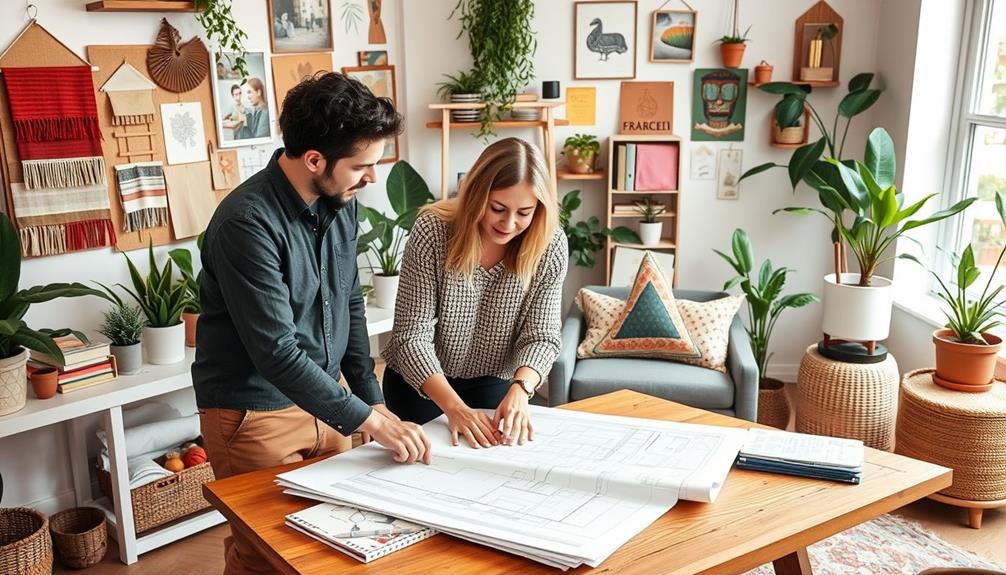
Building strong client relationships is essential for the success of any interior design business, as it not only enhances client satisfaction but also encourages repeat business and referrals.
To effectively build client relationships, you must prioritize effective communication, ensuring regular check-ins and updates throughout the design process. Understanding client needs via active listening and personalized consultations allows you to provide tailored services that foster long-term loyalty.
To enhance your approach, consider the following:
- Implement structured follow-ups post-project completion to maintain ongoing engagement.
- Incorporate personal touches, like handwritten thank-you notes, to create memorable experiences.
- Utilize client feedback to refine your services, demonstrating a commitment to continuous improvement.
- Adapt your design recommendations based on client preferences, showcasing your attentiveness to their desires.
Frequently Asked Questions
How to Begin Your Own Interior Design Business?
To begin your own interior design business, research your target market, define your services, and create a business plan. Register your business, build a professional website, and network to attract clients and opportunities. Offering services such as space planning, furniture selection, and color consultations can attract a diverse range of clients. It’s also important to stay up to date with the latest interior design trends, and continuing education in interior design basics can be beneficial. Additionally, consider joining professional organizations and attending trade shows to further expand your network and stay current in the industry.
Is Interior Design Business Profitable?
Yes, the interior design business is profitable. With strong market growth, high earning potential, and increasing demand for personalized solutions, you can tap into lucrative opportunities, especially if you build a solid client base and reputation.
How to Start an Interior Design Business With No Experience?
You can start by taking online courses to grasp design fundamentals. Redesign spaces for friends or family, build a portfolio, network with industry professionals, and showcase your work on social media to attract clients.
How Do I Start a Freelance Interior Design?
To start freelancing in interior design, define your services, build a portfolio, and create an engaging online presence. Establish clear pricing, network with industry peers, and leverage platforms to attract clients effectively.
Conclusion
In initiating your interior design business journey, remember that "a journey of a thousand miles begins with a single step." Each decision—from defining your service offerings to cultivating client relationships—constitutes an integral stride toward your ultimate vision. As you navigate this intricate landscape, remain reflective and adaptive, continually reassessing not just your design style but also your business strategies and client engagement. By doing so, you'll not only establish a successful enterprise but also foster enduring connections within the industry.
